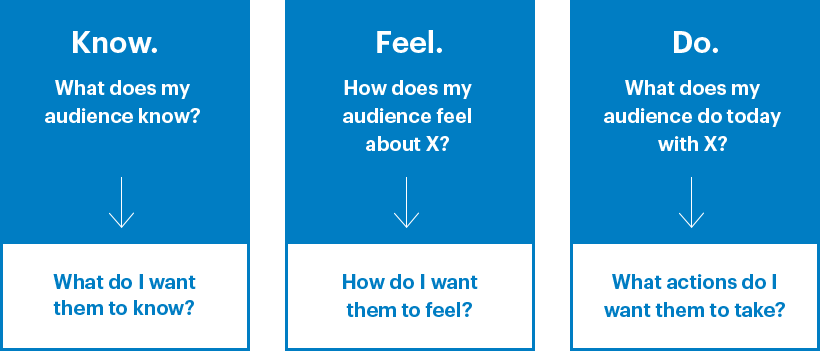I’ve done dozens of change management projects. Usually, they’re disguised as communication campaigns, but when you get right down to it, the company is almost always looking to change behavior. Treating the effort as a communication project alone is dangerous, because you’re not taking into account the challenges presented by what’s hiding inside.
Just like petting a nice sheep, unaware of the wolf within, you can get bit by underestimating what is needed for success.
A standard communication project focuses on knowledge — what the audience knows today and what you want them to know tomorrow. A standard change management project focuses on behavior—what the audience is doing today versus what you want them to do tomorrow. These different objectives demand different approaches.
Know. Feel. Do.
One simple tool I’ve found very helpful in knowing what you’re facing the Know/Feel/Do analysis. Here’s what it looks like:

If you find that most of the activity of the project has to do with giving people new information — for example, making sure employees understand a new pricing model — than you have a genuine communication project. Not much wolf hidden inside of this assignment.
But if you find that while knowledge is important, changing people’s attitudes and actions are required — for example, reinventing your corporate culture — then you have a change management project. And if you’re depending solely on PowerPoint presentations and key messages to succeed, you’re going to fail.
Each of these objectives — know, feel, do — require different tactics to move the needle.
We’re most familiar and comfortable with knowledge tactics:
- Key messages
- Emails
- Articles
- Videos
- Speeches
- Posters
Changing people’s feelings, however, requires a different approach:
- Personalization — How do the facts of the change affect me as an individual?
- Context — Why the change, impact of the change in my business area?
- Emotions — How does this change make me feel? Are the materials inspirational, appropriate, interesting?
- Role models — How does our CEO feel about this, how does my manager feel about this? Are their actions aligned with the change?
- Peers — How do my colleagues feel about this?
- Consequences — What happens if I don’t go along with this? What happens if I do? What are the rewards and consequences for compliance?
Changing people’s behavior requires changes to both knowledge and attitudes — and then a little more:
- Training — Do I have the skills I need to succeed?
- Clear instructions — Do I know exactly what I have to do?
- Feedback — How am I doing so far?
- Reinforcement — Am I being recognized for my efforts?
- Results — Is the change bringing about positive business results? How?
Stakeholders
Creating tactics, from key messages to training programs, requires a lot of work that is not that difficult. A solid communication person and training professional can generally put these materials together relatively quickly. What’s harder is changing attitudes and building acceptance.
That’s where your stakeholders come into play. Who is a stakeholder? Very simply, a person, group or organization that has interest or concern in your project. Some stakeholders are important because they hold the purse strings. Others are vital because they have special needs you must meet to succeed. Others need extra attention because they are influencers — of senior management, of other stakeholders, of employees.
You can’t win the hearts and minds of your audience if you don’t have backing from your stakeholders. In a recent change management project I led, my team and I put together an Excel spreadsheet to help us identify and track our stakeholders. It looked something like this:

As we created our stakeholder plan, we identified distinct stages of the project and what level of support we needed from each stakeholder. We then assigned a value between 1 and 10 to indicate where that stakeholder’s support was currently and where we needed it. We then created action plans for each critical stakeholder to make sure we had the support we needed at each point in the project.
This was a ton of work, and it continued to require a lot of attention throughout the project. But the payoff was clear — we had support from key players when we needed it, and we were able to anticipate and meet the needs of important groups of employees. Fewer surprises meant we could keep to our schedule and budget.
Listening
There’s a lot of lip service given to listening in communications and change, but lip service doesn’t cut it. You have to be willing to listen to feedback, to change your process based on feedback, and to stand up to feedback that doesn’t make sense. No small task.
We built in listening opportunities throughout our process, sponsoring receptions at offices around the world. Our sessions were structured, combining small group work and big group discussion, all sweetened by a great lunch and a light attitude. We took every piece of feedback we received as a gift, and made major modifications to the rollout process as a result. We publicly gave credit to our employees for the positive changes, and urged them to keep the comments coming.
Training
When you’re making technical changes, training is an absolute requirement. We made sure it was available 24/7, translated it into 13 languages, and broke all video training into short, manageable chapters of information. The result? Our folks took the training and were prepared for the change.
Serious work but you can still have a little fun
Just because your project involves serious business issues doesn’t mean that your campaign must be stolid, gray and grumpy. We worked hard to bring some fun into play, from ad hoc celebrations and silly picture opportunities to bright and appealing graphics. Cake was almost always a welcome guest at our gatherings!
Final thoughts
Change management requires planning, organization and a thick skin. It’s not about fancy academic models nor is it about just communication. Surround yourself with a great team who you like, give yourself the gift of time to plan, and prepare for a great ride. Your reward will be when people say to you, “I’ve been through a ton of change efforts at this place, but this is best I’ve ever seen. Great job!”
